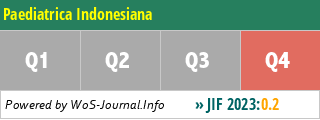Gastroesophageal Reflux (GER)
Keywords:
gastroesophageal reflux; GER; congenital gastrointestinal tract anomalies; lower esophageal sphincter; LESAbstract
Gastroesophageal Reflux ( GER ) is one of the most frequent congenital gastrointestinal tract anomalies. The anatomy and physiology of lower esophageal sphincter (LES) is adapted to prevent reflux in normal infants and children. Vomiting is the most common symptom with following complications: failure to thrive, aspiration penumonia, esophagitis and strictures.
GER is thought to be associated with other diseases such as Sandifer syndrome, rumination and sudden infant death syndrome (SIDS). Upper gastrointestinal series ( UGI series) is the most common and simple diagnostic test in GER.
Management should start with medical therapy such as positional therapy, dietary consideration, and drugs. For non responders, surgical intervention must be considered. In the absence of therapy approximately 60 - 65% of cases will be free of symptoms up till 2 years of age. About 5% of cases will die because of pneumonia and severe malnutrition.
References
methods, J. Pediat. 96 : 798 (1980).
2. ANDERSON, C.B.; BRUKE, V. : Partial thoracic stomach; Gastroesophageal incompetence ("chalasia"), Pediatric gastroenterology, pp. 52 65. (Blackwell Scientific publ., Oxford - London - Edinburg - Melbourne 1975).
3. ARIAGNO, R.L.; GUILLEMINAULT, C. ; BALDWIN, R.; OWEN-BOEDDIKER,M. : Movement and gastroesophageal reflux in awake term infants with 'near miss' SIDS unrelated to apnea, J. Pediat. 100 : 894 (1982).
4. BOIX-OCHOA, J.: GI pressure studies in GER/ Hiatal Hemia, Proc. Ross Conference on pediatric research, pp. 65 - 69 (Ross laboratories, Ohio,1979).
5. BRAY, P.F. : Gastroesophageal reflux mimicking neuropsychiatric syndromes in in childhood, Proc. 76th Ross Conference on pediatric research pp. 81 - 85 (Ross laboratories, Ohio, 1979).
6. BYRNE, W.J.; AMENT, M.E. : GER : the management of infants, children and adolescents, Proc. 76th Ross Conference on pediatric research, pp. 86 ( Ross laboratories, Ohio, 1979).
7. CARRE, I.J. : A historical review of the clinical consequences of Hiatal hernia (Partial Thoracic Stomach) and gastroesophageal reflux, Proc. 76th Ross Conference on pediatric research. pp. 1 - 11, (Ross laboratories, Ohio, 1979).
8. CARRE, I.J. : Anatomy and Physiology of the upper gastro intestinal tract in relation to GER and hiatal hernia, Proc. 76th Ross conference on pediatric research, pp. 12 – 19 (Ross laboratories, Ohio, 1979).
9. CARRE, I.J. : Postural treatment of infant and young children with hiatal hernia (Partial Thoracic Stomach) Proc. 76th Ross Conference on pediatric research, pp. 87 – 91 (Ross laboratories, Ohio, 1979).
10.CHRISTIE, D.L.; 0' GRADY, L.R.; MACK, D.V. : Incompetence of lower esophageal sphincter and gastroesophageal reflux in recurrent acute pulmonary disease of infancy and childhood. J. Pediat. 92 : 2 3 ( 1978).
11.EULER, A.R. : Use of Bethanechol for the treatment of gastroesophageal reflux. J. Pediat 96 : 321 (1980).
12.HARNSBERGER, J.K.; COREY, J .J.; JOHNSON, D.G.; HERBST, J.J. : Longterm follow up of surgery for gastroesophageal reflux in infants and children. J. Pediat. 102: 5 05 ( 1983).
13.HERBST,J.J.; BOOK, L.S.; BRAY, P.F.: Gastroesophageal reflux in the 'near miss' Sudden Infant Death Syndrome, J. Pediat. 92: 7 3 (1978).
14.HERBST, J.J.; MINTON, S.D.; BOOK.; L.S.: Gastroesophageal reflux causing respiratory distress and apnea in newborn infants. J. Pediat. 95 : 7 63 ( 1979).
15.HERBTS, J.J. : Gastroesophageal reflux. J. Pediat. 98 : 8 59 ( 1981).
16.HILLEMEIR, A.C.; LANGE, R.; MC. CALLUM, R.; SEASHORE, J.; GRYBOSKI,J. : Delayed gastric emptying in infants with gastroesophageal reflux, J. Pediat. 98 : 191 (1981).
17.JEFFERY, H.E.; RAHILY, P.; READ, D.J.C.: Multiple causes of asphyxia in infants at high risk for Sudden Infant Death Syndrom, Archs. Dis. Child. 58: 92 (1983).
18.JOHNSON, D.C. : Extended monitoring of esophageal pH in relation to surgical management of gastroesophageal reflux in children, Proc. 76th Ross conference on pediatric research, pp. 77 - 80 (Ross Laboratories, Ohio, 19 79 ).
19.JOLLEY, S.G.; HERBST, J.J.; JOHNSON, D.G.; MATLAK, M.E.; BOOK, L.S. : Surgery in children with gastroesophageal reflux and respiratory symptoms. J. Pediat. 96 : 194 ( 1980).
20. LEAPE, L.L. : Gastroesophageal reflux as a cause of the sudden infant death syndrom, Proc. 76th, Ross conference on pediatric research, pp. 30 - 35 (Ross laboratories, Ohio, 1979).
21.MC. CAULEY, R.G.: Radiological demonstration of GER and Hiatal hernia in infants and children, Proc. 76th Ross conference on pediatric research, pp. 48 - 53, Ross laboratories, Ohio, 1979.
22.ROY, C.C.; SILVERMAN, A. ; COZZETTO, F.J. : Chalasia, Pediatric clinical Gastroenterology, 2nd pp. 150 - 152 (Mosby, Saint Louis 1975).
23.SONDHEIMER, J.M.; MORRIS, B.A.: Gastroesophageal reflux among severely retarded children, J. Pediat. 94:710 (1979).
24. SONDHEIMER, J .M. : Continuous monitoring of distal esophageal pH : A diagnostic test for gastroesophageal reflux in infants, J. Pediat. 99 : 804 (1 980).
25.WALASH, J .K.; FARREL, M.K.; KEENAN, W.J.; LUCAS, M.; KRAMER, M. : Gastroesopahgeal reflux in infants relation to apnea, J. Pediat. 99 : 197 (1981).
26. WORLIN, S.L.; DODDS, W.J.; HEGAN, W.J.; ARNDORVER, R.C. : Mechanism of gastroesophageal reflux in children, J. Pediat. 97 : 244 ( 1980).
27.WILKINSON, J.D.; DUDGEON, D.L.; SONDHEIMER, J.M. : A comparison of medical and surgical treatment of gastroesophageal reflux in severely retarded children, J. Pediat. 99: 202 (1981).
Downloads
Published
How to Cite
Issue
Section
License
Authors who publish with this journal agree to the following terms:
Authors retain copyright and grant the journal right of first publication with the work simultaneously licensed under a Creative Commons Attribution License that allows others to share the work with an acknowledgement of the work's authorship and initial publication in this journal.
Authors are able to enter into separate, additional contractual arrangements for the non-exclusive distribution of the journal's published version of the work (e.g., post it to an institutional repository or publish it in a book), with an acknowledgement of its initial publication in this journal.














